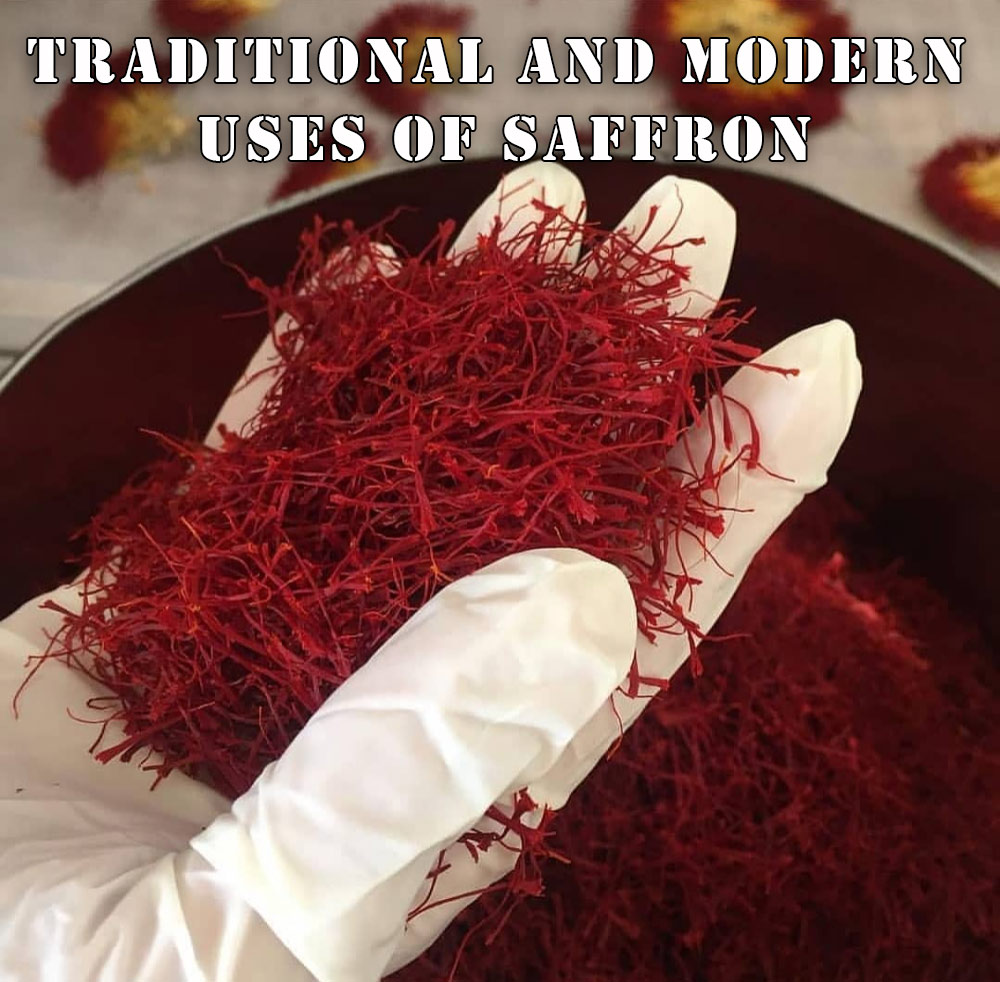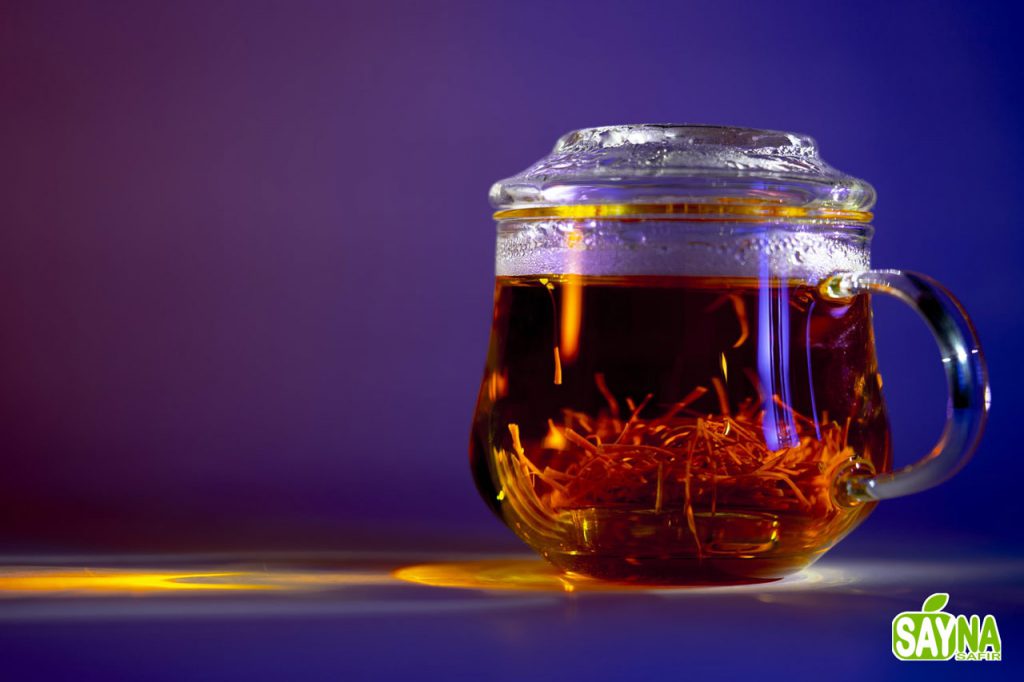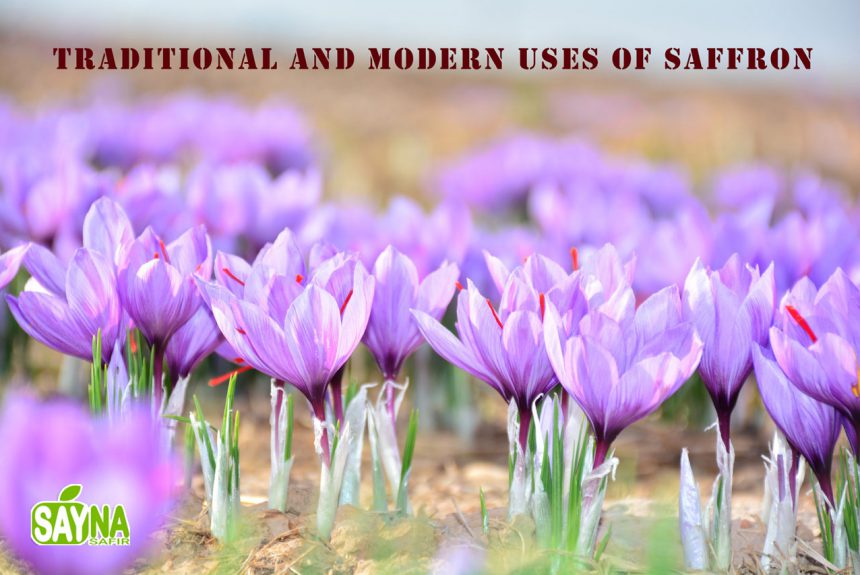Saffron is the most valuable medicinal food product because of its importance in the sustainable development of the production areas of this spice. In this context, the traditional production of saffron in Iran has many strengths and undeniable comparative advantages favoring its commercial development and its insertion into the networks of organic farming, fair trade and solidarity tourism. The dried stigmas of the plant Crocus sativus are used in saffron as a well-known spice that has other significance in the pharmaceutical industries, textile dyes, and especially cosmetics; nowadays, the latter is ubiquitous and based on the incorporation of healthy and natural ingredients. Recently, information on the pharmacological activity of this plant has given it a prominent place in the Codex, where several pharmaceutical preparations were containing the famous stigmas. More recently, saffron has attracted a renewal interest for its use in cosmetic. Beside the well described and widespread antioxidant properties, saffron presents multiple interests for cosmetic applications such as anti-solar, anti-pigmentation and anti-aging activities, and could also be used as a pigment or in perfumes. However, its delicate cultivation, its low yield linked to mainly manual picking and pruning, and the numerous falsifications of which it is the victim, generate a reduced use not accessible to any consumer because of an excessive price.
Botanical Description
The saffron plant belongs to the Iridaceae family. This herbaceous perennial plant (Figure 1.A) reaches 10 to 25 cm in height developing from its bulbs. The bulb, of sub-ovoid shape, is of variable size and forms. It has a massive structure and is covered by many concentric spathes. Each mother bulb produces from apical buds one to three large daughter bulbs and several small bulbs from lateral buds . Saffron has two types of roots: fibrous and thin roots at the base of the mother bulb, and contractile roots formed at the base of the lateral buds (Figure 1.B). The leaves vary from five to 11 per bud (Figure 1.C). They are very narrow and measure between 1.5 and 2.5 mm of dark green color. They measure 20 to 60 cm in length with a whitish band in the inner part and a rib on the outside.

The flowers of Crocus sativus begin to appear at the beginning of autumn, towards the end of September of purple color composed of six tepals, three are internal, whereas the three others are external, which meet at the long tube that arises from the upper part of the ovary (Figure 1.C). At their appearance, the flowers are protected by whitish membranous bracts. The pistil is composed of an inferior ovary from which a thin style, 9 to 10 cm long, arises. The style ends with a single stigma composed of three filaments of intense red color whose length exceeds that of the tepals, which are the part of the plant interesting for the man from the point of view of culture.
Main Phytochemical Components of Saffron
Chemical analysis of C. sativus stigmas has shown the presence of about 150 volatile and non-volatile compounds. Fewer than 50 constituents, however, have been identified so far . The three main biologically active compounds are:

- (1) Crocin, a carotenoid pigment responsible for the yellow-orange color of the spice.
- (2) Picrocrocin, bringing saffron flavor and bitter taste.
- (3) Safranal, a volatile compound responsible for the aroma and smell so specific to saffron.

Cosmetology and Perfumery Uses of Saffron
More recently, saffron has attracted a renewed interest for its use in cosmetics. Since ancient times, saffron is used for cosmetic purposes, absorbed in infusion or even in the cutaneous application, mixed with fat or macerated in donkey milk, for its eternal youthful properties. Cleopatra used it in her beauty products. In traditional Iranian medicine, saffron can improve the complexion and can be used to treat erysipelas. In traditional Greek medicine, it can refresh the skin of the face and is used to relieve the liver of the domination of bile and to treat acne, skin diseases and wounds. In addition, the body may look younger and brighter [23,24]. In another category, Hindu women used saffron to make the bindi, the yellow dot on the forehead. It is, in a way, a third eye symbolizing good fortune and conscience [25]. Nowadays, saffron tepals have been studied in several studies as being rich in crocin and kaempferol, thus representing an important source of bioactive compounds for potential cosmetic formulations [26,27]. Beside the antioxidant properties, saffron presents multiple interests for cosmetic applications. The most promising activities are listed hereafter.
1. Anti-UV Agent
Prolonged exposure to the sun is extremely harmful because it puts the skin in contact with UV rays, known to cause serious lesions. Saffron is known to have anti-sun effects that can protect the skin from harmful UV rays. Studies show that saffron lotion may be a better sunscreen than homosalate (an organic compound used in some sunscreens). Thus, saffron can be used as a natural UV absorbing agent [28,29]. In addition to the antisolar and moisturizing properties of saffron, the prevention of skin cancers by saffron because of its antioxidant properties is important as well [30,31].
2. Redness of Dark Spots
Saffron is known to reduce the pigment called melanin. Thus, it is very effective as a lightening agent for the skin. The formulation containing C. sativus extract caused significant depigmentation and anti-rhythmic effect on human skin [32]. Melanocytes produce melanin in skin as a mixture of two pigments eumelanin and phaeomelanin, which are (brown black) and (red yellow) respectively [33]. Melanogenesis is accomplished by a series of oxidative reactions controlled by various enzymes. Tyrosinase is the main catalyst for this phenomenon [34]. Antioxidant activity is mainly exhibited by monoterpenoids, crocin, quercetin, kaempferol, and by other phenolic components of C. sativus. The mode of action of these compounds to reduce skin melanin is by inhibiting the activity of tyrosinase [35].
3. Anti-Aging Effect and Diseases of the Skin
In traditional herbal cosmetics uses, saffron can be soaked with a few basil leaves to treat blemishes such as acne. A mixture of soaked saffron strands and virgin coconut oil, or olive oil, and a bit of raw milk is an effective way to exfoliate and improve blood circulation face skin. Saffron is known to reduce a skin condition called erythema, characterized by inflammation, redness or rash. Saffron is rich in antioxidants expected to inhibit the expression of markers of inflammation such as tumor necrosis factor (TNF) and interleukin. An application of the formulation containing 3% C. sativus extract to human skin may be useful in the management of melanoma. Similar effects have been reported by Moshiri et al. who found that clinical trials on the anti-pruritic and skin-promoting effects on saffron’s effects on skin care both confirmed that saffron was more effective than placebo [36].
4. Perfumery
Once dried, the spice releases a pleasant aroma described by Aristophanes as a “sensual smell” (Clouds 51) admired by the Greeks [37]. It is from safranal, which is the main odoriferous compound of saffron that we obtain the note “saffron”. In ancient Greece (around 2000 to 146 BC), saffron was a royal dye and was used as a perfume in salons, courts, theaters and bathrooms. Later, its use spread among ordinary people [38,39]. Additionally, during the Parthian Dynasty, they used saffron among the ingredients of a royal scent, which included a refreshing oil facial for kings and ritual leaders [40]. Today, we find this woody, sweet note and harmonious in the composition of different perfumes both feminine and masculine, with an original and exotic potential.
5. Saffron as Natural Pigments in Cosmetics
Historically, plant pigments such as curcumin, beet anthocyanins, carotenoids from peppers, chlorophyll from green leaves and saffron, have been used to color food and cosmetics, for centuries. Nowadays, many commercially used cosmetics are made with the synthetic colorants, which can cause side effects due to prolonged use. However, the current trend matches towards healthy natural ingredients incorporated within these cosmetic products. In cosmetics, saffron has been used at low levels due to its high cost. It has been used as a substitute for turmeric where light exposure would cause fading of turmeric. It also used as a substitute for tartrazine [41].
Pharmacological Study of Saffron
Since ancient times, plants have been used in every civilization, worldwide, as a source of traditional medicine. For more than 3000 years, saffron has been considered a panacea, according to Ayurvedic, Mongolian, Chinese, Egyptian, Greek and Arabic medicines. Some therapeutic properties attributed to saffron are listed below.
1. Antidepressant
The use of saffron as an antidepressant has a long tradition, ranging from antiquity to modern times. Depression is one of the five most prevalent diseases worldwide. It affects about 11.6% of the world’s population [42]. It is predicted that by 2020 this will be the second leading cause of overall disability. Similar to standard antidepressants, saffron can exert its antidepressant effect by modulating the level of certain chemicals in the brain, including serotonin. Serotonin, or 5-hydroxytryptamine, is a mood-elevating neurotransmitter synthesized from tryptophan [43]. Although not appearing as a medicinal herb used traditionally, crocus petals are significantly less expensive than stigmas, prompting researchers to examine their potential in treating depression. Thus, a trial comparing the efficacy of petals and stigmas suggests that they are equally effective in the treatment of mild to moderate depression [44,45].
2. Treating Sexual Dysfunction
Saffron, as well as other spices, have always enjoyed a reputation as an aphrodisiac in different Egyptian, Greek, Roman and other civilizations. Traditionally, Muslims, Phoenicians and Chinese use saffron as a sexual stimulant [46]. The aphrodisiac activities of the aqueous extract of stigmas of C. sativus and its constituents, safranal, and crocin, were evaluated. It appears that saffron can, without risk, effectively combat certain fluoxetine-induced sexual disorders in women such as excitement, lubrication, or pain [47]. Saffron has shown a positive effect on sexual function with an increase in the number and duration of erections in patients with erectile dysfunction–even after treatment for only 10 days [48].
3. Antioxidant
Carotenoids, which include crocin and crocetin, play an important role in health by acting as natural antioxidants. They protect cells and tissues from the detrimental effects of free radicals and reactive oxygen species (ROS). Crocin is the most studied active ingredient with regard to the antioxidant properties of saffron. However, it does not act alone—but thanks to work in synergy with other components such as safranal, dimethylcrocetin and flavonoids [49]. Other studies focused on the negative effects of oxidative stress on our brain, since it is the organ most exposed to oxidation, due to the high phospholipid content of neuronal membranes and the existing link with development of neurodegenerative pathologies such as Alzheimer’s disease, whose treatment with saffron can prevent the aggregation and deposition of amyloid β peptide in the human brain and can, therefore, be useful in Alzheimer’s disease [50].
4. Anticarcinogenic
Cancer is the leading cause of death worldwide. Epidemiological evidence indicates that there is a correlation between a diet rich in antioxidants and a lower incidence of morbidity and mortality. Among the natural remedies, saffron and its ingredients (especially its carotenoids) have anti-tumor and anti-carcinogenic activities while not exerting any cytotoxic effect on healthy cells. A wide variety of natural substances has been identified as having the ability to induce apoptosis in various tumor cells. Among the many biological properties reported with saffron, those anti-carcinogens are of great interest and are extensively studied by experiments both in vitro and in vivo [51,52]. Abdullayev et al. found that naturally occurring saffron extract—in combination with two synthetic compounds—sodium selenite or sodium arsenite, may have a synergistic effect with saffron and may, therefore, have an important role in cancer chemo prevention [53]. Likewise, Botsoglou [54] demonstrated that the inhibitory effects of saffron against different malignant cells was dose dependent as well. Saffron pretreatment for five consecutive days prior to the administration of anti-tumor drugs, including cisplatin, significantly inhibited anti-tumor drug induced cellular DNA damage [55].
5. Antispasmodic and Digestive Tonic
Virtues have been attributed to saffron concerning the gastrointestinal and genital system, in particular, those of stimulating the stomach, reducing appetite, treating hemorrhoids, treating anus prolapse, limiting intestinal fermentations, helping with the treatment of amenorrhea, or to stimulate menstruation—and not to mention its abortifacient power [56]. Safranal normalized gastric volume and pH, reduced the surface of gastric ulcer and produced gastric protection. In addition, it was able to improve the histological changes induced by indomethacin and the biochemical alterations of tissues [57].
6. Anti-Inflammatory and Analgesic Effect
There is great interest in natural compounds such as dietary supplements and herbal remedies used for centuries to reduce pain and inflammation [58]. Extracts and tinctures of saffron have been used to treat fever, wounds, lower back pain, abscesses, and gingivitis as well as pain related to the eruption of the first teeth in infants [56]. Aqueous and alcoholic extracts of stigmas and saffron petals have an antinociceptive and anti-inflammatory activity for both acute and chronic pain [59].
7. Effect on Cholesterol Levels
Nibbling is one of the dietary habits that are difficult to control, predisposing to weight gain and, consequently, obesity and subsequent metabolic complications (dyslipidemia, non-insulin-dependent diabetes, circulatory disorders, hypertension, chronic kidney disease, etc.). It mainly affects the female population and is frequently associated with stress. Due to the presence of crocetin, saffron indirectly helps to lower cholesterol levels in the blood and thus the severity of atherosclerosis, reducing the risk of a heart attack [60]. The hypolipidemic effect of crocin is attributed to the inhibition of pancreatic lipase, thus limiting the absorption of fats and cholesterol [61]. Previous studies have concluded that saffron has shown anti-obesity and anorectic effects in obese rat models. This thanks to its effect on the reduction of caloric intake by blocking the digestion of dietary fats via the inhibition of pancreatic lipase; the feeling of satiety due to the increased level of neurotransmitters without forgetting its role in the improvement of glucose and lipid metabolism, [62]. In addition, crocin has shown a significant decrease in the rate of body weight gain, total fat deposition, and regulates the weight ratio of body fat to the epididymis [63].
8. Effect on Blood Glucose and Insulin Resistance
The use of high-dose crocetin (40 mg/kg) counteracts the development of insulin resistance by avoiding compensatory hyperinsulinemia; in fact, it limits dyslipidemia by maintaining the values of free fatty acids, triglycerides and LDL-c (Low Density Lipoprotein) in norms and avoids hypertension induced by a diet supplemented with fructose [59].
9. Healing of Second-Degree Burns
10. Effects on the Eyes
Saffron has been used traditionally by different nations for various eye diseases such as corneal disease, sore eyes, cataracts and purulent eye infection [65,66]. The kohl pencil was used in Egyptian antiquity. It is still used today to make eyes black. In fact, oriental women used it to protect themselves from attacks related to the sun, the wind, the sand and possibly ocular infections as well. Kohl was, in fact, a very fine powder obtained by grinding cloves, rosewood, saffron, and antimony [62]. Current investigations show that saffron extract can reduce eye diseases such as cataracts [67], retinal degeneration [68], light-mediated photoreceptor cell death [69], and improves blood circulation and retinal function [70].

Old Uses of Saffron
Culinary Use
From antiquity to the present day, and all over the world, most of the saffron produced was, and is still used, in cooking. Its aroma is described by chefs and saffron specialists as resembling honey, but with metallic notes [71]. Saffron is used in India, Iran, Spain and other countries as a condiment for rice. In Spanish cuisine, it is used in many dishes such as Paella Valenciana, a specialty made from rice, and zarzuela, made from fish. Saffron is also used in French bouillabaisse, a spicy fish soup, Italian Milanese risotto and saffron cake. Iranians use saffron in their national dish—chelow kabab. Indian cuisine uses saffron in its biryanis, traditional dishes made from rice. It is also used in some candies such as gulabjaman and kulfi [72]. In Morocco, saffron is used in tea instead of mint, but also as a spice in the preparation of various traditional dishes including koftas (meatballs and tomatoes) or mrouzia (a sweet-salty dish made from mutton or dill). Saffron is also a central ingredient in the blend of chermoula herbs that perfume many Moroccan dishes [73].
Coloring Power
The harmful effect of synthetic food dyes has led to their banning in some countries and the return to natural dyes. The use of saffron as much as an alternative dye is advantageous in the field of agro-food thanks to the high solubility of crocine in water [74]. Thus, the powerful dyeing power of saffron—which could also be used in cosmetic—has been used for a long time to color butter, pasta, cheeses, and oleomargarines. The golden yellow color of saffron is used in painting, textiles. The saffron solutions remain largely stable in alkaline and acidic medium. This property is due to crocin pKa (acid dissociation constant), dicarboxylic acids, esters, and nitrogen compounds. Saffron buffers solutions reduce the oxidation of cellulose. Saffron continues to dye the clothes of Buddhist monks, silk, wool, and Oriental carpets. Natural dyes have better biodegradability and compatibility with the environment, lower toxicity and less allergenic than some of the synthetic dyes.
Ref: MDPI


Leave a Reply